1.7: Hors d’ Oeuvre, Caviar and Buffet Presentation
- Page ID
- 23630
\( \newcommand{\vecs}[1]{\overset { \scriptstyle \rightharpoonup} {\mathbf{#1}} } \)
\( \newcommand{\vecd}[1]{\overset{-\!-\!\rightharpoonup}{\vphantom{a}\smash {#1}}} \)
\( \newcommand{\id}{\mathrm{id}}\) \( \newcommand{\Span}{\mathrm{span}}\)
( \newcommand{\kernel}{\mathrm{null}\,}\) \( \newcommand{\range}{\mathrm{range}\,}\)
\( \newcommand{\RealPart}{\mathrm{Re}}\) \( \newcommand{\ImaginaryPart}{\mathrm{Im}}\)
\( \newcommand{\Argument}{\mathrm{Arg}}\) \( \newcommand{\norm}[1]{\| #1 \|}\)
\( \newcommand{\inner}[2]{\langle #1, #2 \rangle}\)
\( \newcommand{\Span}{\mathrm{span}}\)
\( \newcommand{\id}{\mathrm{id}}\)
\( \newcommand{\Span}{\mathrm{span}}\)
\( \newcommand{\kernel}{\mathrm{null}\,}\)
\( \newcommand{\range}{\mathrm{range}\,}\)
\( \newcommand{\RealPart}{\mathrm{Re}}\)
\( \newcommand{\ImaginaryPart}{\mathrm{Im}}\)
\( \newcommand{\Argument}{\mathrm{Arg}}\)
\( \newcommand{\norm}[1]{\| #1 \|}\)
\( \newcommand{\inner}[2]{\langle #1, #2 \rangle}\)
\( \newcommand{\Span}{\mathrm{span}}\) \( \newcommand{\AA}{\unicode[.8,0]{x212B}}\)
\( \newcommand{\vectorA}[1]{\vec{#1}} % arrow\)
\( \newcommand{\vectorAt}[1]{\vec{\text{#1}}} % arrow\)
\( \newcommand{\vectorB}[1]{\overset { \scriptstyle \rightharpoonup} {\mathbf{#1}} } \)
\( \newcommand{\vectorC}[1]{\textbf{#1}} \)
\( \newcommand{\vectorD}[1]{\overrightarrow{#1}} \)
\( \newcommand{\vectorDt}[1]{\overrightarrow{\text{#1}}} \)
\( \newcommand{\vectE}[1]{\overset{-\!-\!\rightharpoonup}{\vphantom{a}\smash{\mathbf {#1}}}} \)
\( \newcommand{\vecs}[1]{\overset { \scriptstyle \rightharpoonup} {\mathbf{#1}} } \)
\( \newcommand{\vecd}[1]{\overset{-\!-\!\rightharpoonup}{\vphantom{a}\smash {#1}}} \)
\(\newcommand{\avec}{\mathbf a}\) \(\newcommand{\bvec}{\mathbf b}\) \(\newcommand{\cvec}{\mathbf c}\) \(\newcommand{\dvec}{\mathbf d}\) \(\newcommand{\dtil}{\widetilde{\mathbf d}}\) \(\newcommand{\evec}{\mathbf e}\) \(\newcommand{\fvec}{\mathbf f}\) \(\newcommand{\nvec}{\mathbf n}\) \(\newcommand{\pvec}{\mathbf p}\) \(\newcommand{\qvec}{\mathbf q}\) \(\newcommand{\svec}{\mathbf s}\) \(\newcommand{\tvec}{\mathbf t}\) \(\newcommand{\uvec}{\mathbf u}\) \(\newcommand{\vvec}{\mathbf v}\) \(\newcommand{\wvec}{\mathbf w}\) \(\newcommand{\xvec}{\mathbf x}\) \(\newcommand{\yvec}{\mathbf y}\) \(\newcommand{\zvec}{\mathbf z}\) \(\newcommand{\rvec}{\mathbf r}\) \(\newcommand{\mvec}{\mathbf m}\) \(\newcommand{\zerovec}{\mathbf 0}\) \(\newcommand{\onevec}{\mathbf 1}\) \(\newcommand{\real}{\mathbb R}\) \(\newcommand{\twovec}[2]{\left[\begin{array}{r}#1 \\ #2 \end{array}\right]}\) \(\newcommand{\ctwovec}[2]{\left[\begin{array}{c}#1 \\ #2 \end{array}\right]}\) \(\newcommand{\threevec}[3]{\left[\begin{array}{r}#1 \\ #2 \\ #3 \end{array}\right]}\) \(\newcommand{\cthreevec}[3]{\left[\begin{array}{c}#1 \\ #2 \\ #3 \end{array}\right]}\) \(\newcommand{\fourvec}[4]{\left[\begin{array}{r}#1 \\ #2 \\ #3 \\ #4 \end{array}\right]}\) \(\newcommand{\cfourvec}[4]{\left[\begin{array}{c}#1 \\ #2 \\ #3 \\ #4 \end{array}\right]}\) \(\newcommand{\fivevec}[5]{\left[\begin{array}{r}#1 \\ #2 \\ #3 \\ #4 \\ #5 \\ \end{array}\right]}\) \(\newcommand{\cfivevec}[5]{\left[\begin{array}{c}#1 \\ #2 \\ #3 \\ #4 \\ #5 \\ \end{array}\right]}\) \(\newcommand{\mattwo}[4]{\left[\begin{array}{rr}#1 \amp #2 \\ #3 \amp #4 \\ \end{array}\right]}\) \(\newcommand{\laspan}[1]{\text{Span}\{#1\}}\) \(\newcommand{\bcal}{\cal B}\) \(\newcommand{\ccal}{\cal C}\) \(\newcommand{\scal}{\cal S}\) \(\newcommand{\wcal}{\cal W}\) \(\newcommand{\ecal}{\cal E}\) \(\newcommand{\coords}[2]{\left\{#1\right\}_{#2}}\) \(\newcommand{\gray}[1]{\color{gray}{#1}}\) \(\newcommand{\lgray}[1]{\color{lightgray}{#1}}\) \(\newcommand{\rank}{\operatorname{rank}}\) \(\newcommand{\row}{\text{Row}}\) \(\newcommand{\col}{\text{Col}}\) \(\renewcommand{\row}{\text{Row}}\) \(\newcommand{\nul}{\text{Nul}}\) \(\newcommand{\var}{\text{Var}}\) \(\newcommand{\corr}{\text{corr}}\) \(\newcommand{\len}[1]{\left|#1\right|}\) \(\newcommand{\bbar}{\overline{\bvec}}\) \(\newcommand{\bhat}{\widehat{\bvec}}\) \(\newcommand{\bperp}{\bvec^\perp}\) \(\newcommand{\xhat}{\widehat{\xvec}}\) \(\newcommand{\vhat}{\widehat{\vvec}}\) \(\newcommand{\uhat}{\widehat{\uvec}}\) \(\newcommand{\what}{\widehat{\wvec}}\) \(\newcommand{\Sighat}{\widehat{\Sigma}}\) \(\newcommand{\lt}{<}\) \(\newcommand{\gt}{>}\) \(\newcommand{\amp}{&}\) \(\definecolor{fillinmathshade}{gray}{0.9}\)What is the difference between appetizers and hors d’oeuvre? Here is the best way to distinguish between the two. Think of appetizers as the first course of a meal. Hors d’ oeuvre on the other hand are typically small bites that are served during a cocktail hour before the meal seating. Hors d’ oeuvre are typically “passed” or served on trays carried by butlers throughout a room of guests who have a glass of wine or a cocktail in one hand and a delightful hors d’ oeuvre in the other.
Translated from the French, hors d’ oeuvre means “outside the work”. Though English has no equivalent to this, I have always explained it, so or not, that we think of it as something outside of the chef’s normal day to day tasks. If you think of it, not every day do we have an event that requires such attention to passed hors d’ oeuvre. There is a phrase the French use that I love when thinking of small bites – ‘amuse bouche’. It means, “Excite the palate” or quite literally, “happy mouth”. Many restaurants offer one of these bite sized hors d’ oeuvre when you are seated and when done with thought it should offer a window into the chef’s style or that evening’s offerings.
Appetizers are part of a meal vs. Hors d’ oeuvre, which are apart from the meal.
Types of Hors d’oeuvre
- Hot- sausages, smoked fish or meat, Potato Napoleon with caviar and sour cream etc.
- Cold- Pates, oysters, cheeses, crudités etc.
- Finger food- empanadas, wontons, deviled quail eggs, tea sandwiches
- Canapés- 1 or 2 bites- always consists of four parts
- Base
- Spread
- Primary ingredient
- Garniture
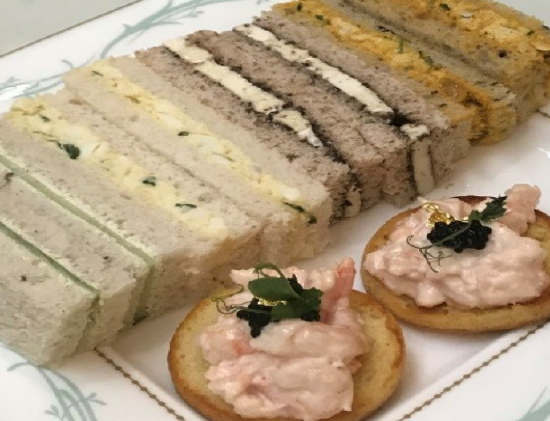
Finger sandwiches and canapés- commons.wikimedia.org
We’ve all heard of parties where the host serves “heavy hors d’ oeuvre” and today this can encompass selections which go beyond the one or two bite norm which we have always thought of regarding hors d’ oeuvre. At such receptions, these can be served from a stationary location with plates and utensils.
Hors D’ Oeuvre Service Styles
- Passed- Butler Style
- Stationary Buffet
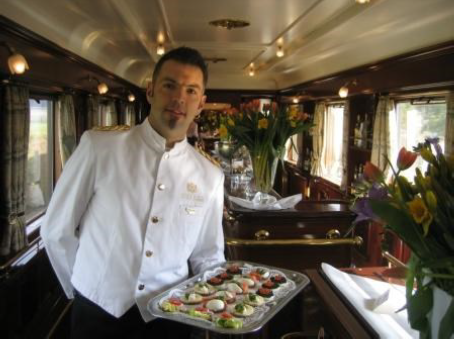
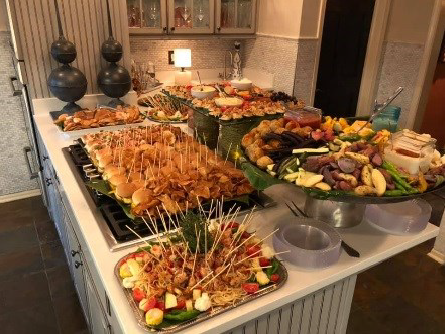
Passed - commons.wikimedia.org, Buffet- photo courtesy of Keith Hand Bridge Catering, Atlanta Georgia

International Interpretations
- England- Starters
- France- Hors d’ Oeuvre
- Spain- Pinchos or tapas
- Greece- Mezzes
- Italy- Antipasti
- Russia- Rakuski
Composed Hors d’oeuvre are built from two or more ingredients that are more often than not made ahead in preparation for an event. Some common vehicles for presentation include barquettes, canapés, profiteroles, tartlets, bouchees, and spoons (either non-edible or edible).
Barquettes and Tartlets
Barquettes are small boat shaped pastry shells (usually neutral in flavor) that hold various hors d’oeuvres, especially mousses. Tartlets are very similar except for their more rounded and often fluted shape. Barkettes should always have a fish or shellfish component because the boat shape signifies such.
When using the basic pate dough recipe it is important to roll the dough very thinly and invert the mold on top of the dough. Cut around the mold allowing some extra dough around the edge. This will allow room for the dough to fill the mold inside and reach the top of the sides. Press another mold inside the dough to contour the dough to the first mold.
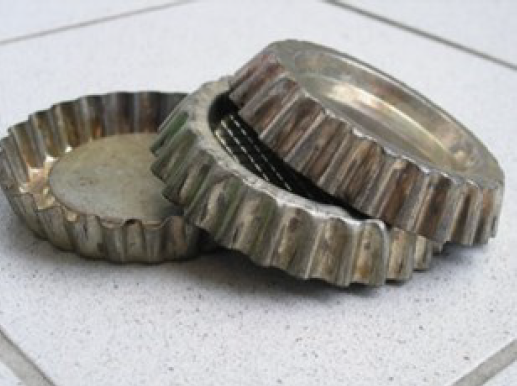
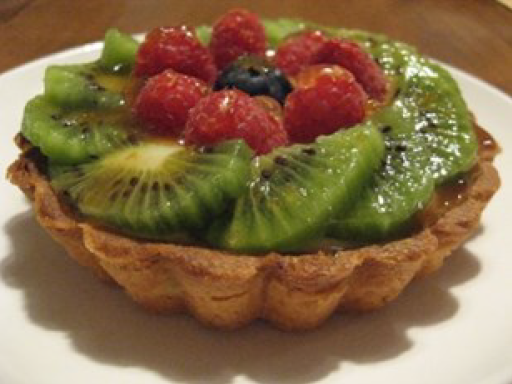
Tartlet molds Fruit tartlet Commons. Wikimedia.org Commons.wikimedia.org
Profiteroles
These are small hollow ball shaped puffs of baked pate a choux. They can be filled with sweet or savory ingredients.
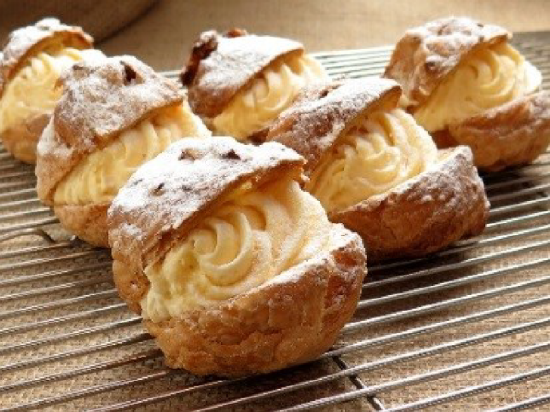
Profiteroles. Goodfreephotos.com
Bouchees
Bouchees are made of puff pastry into tiny bowls with straight and often fluted sides. The tops can be cut away for garnish and the cylindrical bowl filled with a delicious filling. The photo shown is of a mini bouchees filled with crawfish etouffee and garnished with chives.
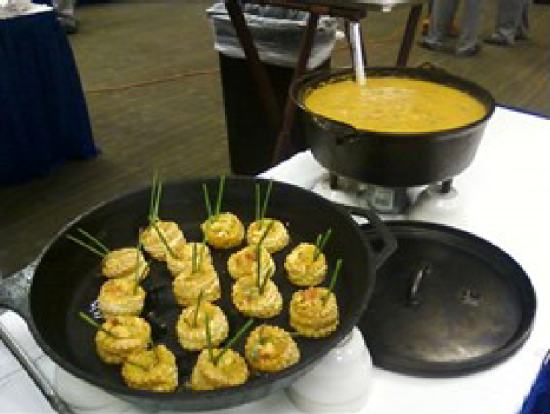
Mini-bouchees
Canapés
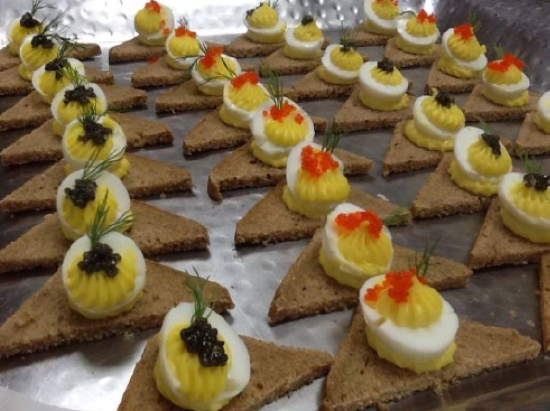
Canapés, Photo credit: Marshall Welsh CEC Emeritus
One of the most common forms you will see in catering hors d’ oeuvre is the canapé. Think of it as a miniature open-faced sandwich with four parts.
- Base - usually a toast point
- Spread - this adds flavor, moisture, and helps the next part adhere to the base
- Main ingredient - meat, vegetable, mousse, cheese etc.
- Garnish - a must have to dress up the offering
Bases can also be a vegetable or fruit but must be strong enough to support the other ingredients. Today the use of Asian style soup spoons are popular and add the ability to use sauces that otherwise would create a mess. Lately the use of edible spoons made with a cracker dough have been introduced so the novelty of a completely edible delivery mechanism.
Spreads can made from compound butters, flavored cream cheeses or mayonnaises, and bound salads such as chicken, ham, tuna, or egg. It is helpful to finely cut the ingredients for a miniature presentation.
Main ingredients can carry the load of the primary flavor presented or can accompany another part. Perhaps your base is a truffle mayonnaise with earthy flavor; the main ingredient should complement the base in this case. Main ingredients should harmonize with other flavors in the recipe. In some cases, the primary ingredient could be a charcuterie item as in smoked fish or meat; either could be presented as a mousse. At other times cheese, vegetables, and fruits are used and at times together for variety among your guest’s choices.
Garnishes must be proportional and consistent in size and placement when making canapés. They are however, little artful creations that “Wow” the guests. Some common garnishes include caviar, capers, chives, salmon roe, nuts, fruits, and herbs.
In conclusion, remember that completion of organized mise en place is essential to success when making all of these types of hors d’ oeuvre. Store the ingredients at proper temperatures. Toast points should be wrapped and at room temperature, while spreads and main ingredients usually at 41°F or below. Always plan ahead, and adhere to a strict production schedule.
Refer to course handouts and or recipes provided by your instructor via the LMS (Learning Management System) ex. Moodle®.
Caviar
As mentioned earlier, caviar can be used as an accompaniment for many hors d’ oeuvre. Be open-minded if you have never tasted caviar. I love it; others not so much but one thing I have witnessed in years of teaching is that I am often surprised that many students who never had it like it when they approach it with an open mind. After all, we are in this together to become chefs; are we not? So here we go; let us learn about caviar.
What is caviar?
Caviar is the roe or “eggs” of the fish and only the roe from sturgeon fish is legally considered caviar. The roe can be 10-50% of the fish’s weight and traditionally the Caspian Sea is where we harvest the most caviar in the entire world. Of the roe harvested in the Caspian, Russia produces 90% while Iran produces around 10%. It is important to note that California has White Sturgeon farms producing caviar here in America.
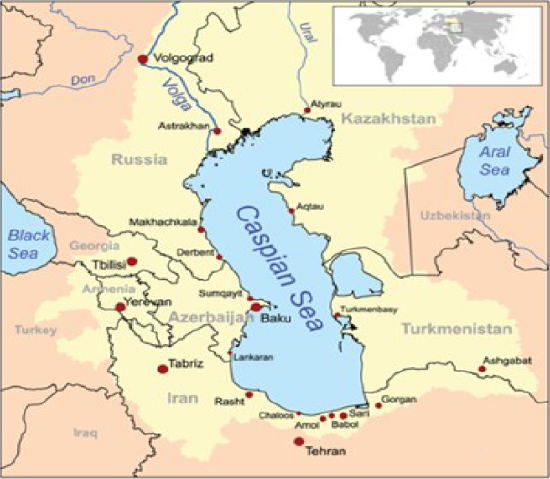
Caspian Sea- commons.wikimedia.org
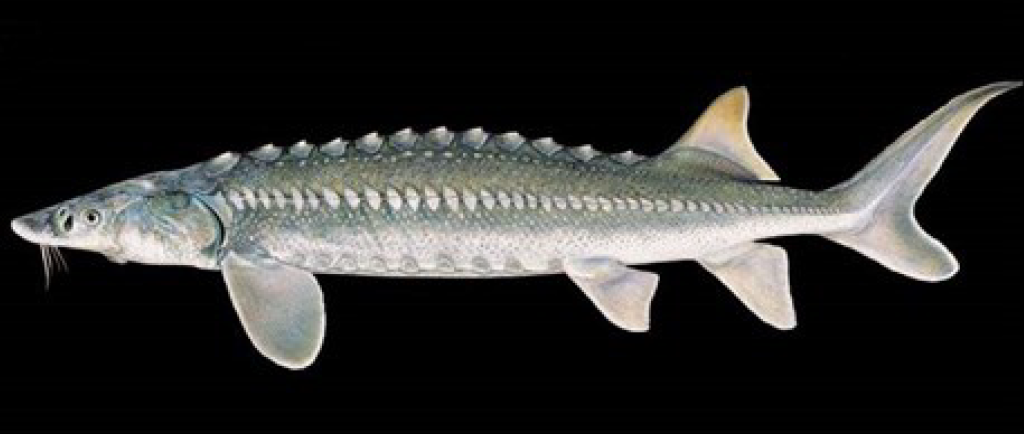
The Acipenser or White Sturgeon- commons.wikimedia.org
Are there other Caviars?
Yes, you will see other fish roes labeled with the word caviar on the jars just as you see tomato bisque on a menu even though you know a bisque requires shellfish in the ingredients. When we go to a sushi restaurant, we often see “flying fish roe” and “salmon roe”. On the grocery store dry shelf, we can find jars of “lump fish” labeled caviar. In the Bayou Region of South Louisiana, we have a unique player in the market for a prehistoric fish known at Choupique. Louisianans have long eaten this fresh fish in fried and fishcake forms. The fish must be kept alive, processed and eaten, or frozen right away or loses its goodness. The roe from the Choupique is harvested in winter months, and salted before canning in jars. It has a shiny jet-black color and is typically saltier that most sturgeon caviar.

The Choupique or “Bowfin”- commons.wikimedia.org
Caviar Quality
Caviar is graded several factors including consistency of grain (size), color, firmness, fragrance, flavor, gleam, and the vulnerability of the roe skin. Sizes and graded 000, 00, medium and small. Lighter colors are more favored and graded higher.
Caviar Preservation for Market
The addition of salt preserves the product for sale. Normally 5-8 % of the product’s weight in salt is added but if the end-product is labeled “Malossol” it has only 2-3% salt by weight and is excellent. Malossol means “little salt.
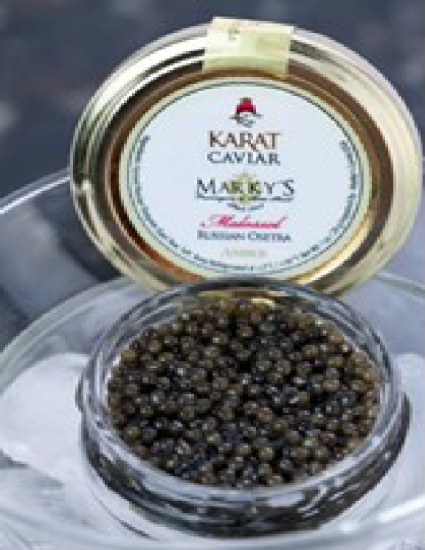
Russian Malossol Osetra Caviar, commons.wikimedia.org
The Three True Caviars
- Beluga
- Osetra
- Sevruga
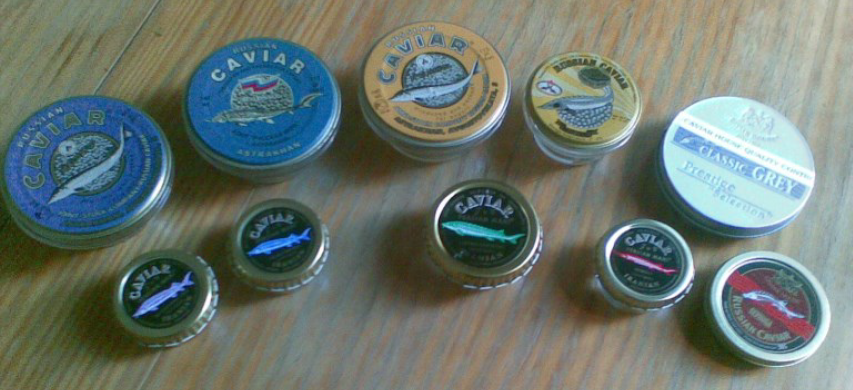
Beluga, Osetra, and Sevruga caviars- commons.wikimedia.org
Beluga Roe
Beluga is the largest but the most fragile roe. Its characteristics are soft, clear, and glossy eggs that are heavy and well separated. The color ranges from light silver-gray to black and is noted for a smooth creamy taste. The eggs have a dark eye, which is the embryo itself. As with most caviars, beluga is usually handled with a caviar spoon made of mother of pearl, bone, or other nonmetallic material. Metal utensils tend to impart an unwelcome metallic taste to the delicate and expensive roe. Beluga caviar is usually served by itself on toast, unlike other less expensive caviars that can be served in a variety of ways, including hollowed and cooked new potatoes, on a blini, or garnished with sour cream, crème fraiche, minced onion, or minced hard-boiled egg whites. These items can, however, be served with beluga as palate cleansers. Beluga caviar is the most expensive and always has a blue colored tin or jar lid.
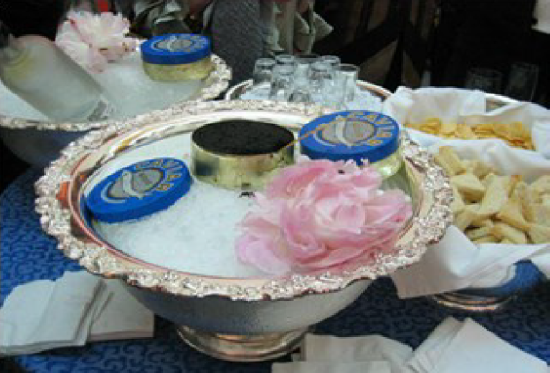
Beluga Caviar-commons.wikimwdia.org
Osetra Roe
Osetra roe is dark brown to gray in color and has medium sized grain to the eggs. It is notably more nutty and oily in flavor than Beluga. Osetra caviar is one of the most prized and expensive types of caviar eclipsed in price only by Beluga caviar. It is obtained from the Osetra sturgeon that weighs 50-400 pounds and can live up to 50 years.
Osetra caviar varies in color from deep brown to gold. Lighter varieties are in greater demand as they have the richest flavor and come from the oldest of sturgeon. Golden Osetra is a rare form of Osetra caviar, and is golden-yellow in color with a very rich flavor. As with other caviars, Osetra is traditionally served on blinis with crème fraiche. Lower-grade varieties of caviar are used as stuffing in many seafood dishes, and some meat dishes. Caviar is often an addition to salads as well. Osetra caviar is always sold in tins or jars with yellow lids.
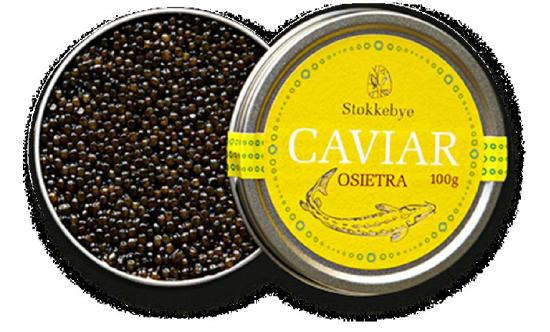
Sevruga Roe
The smallest of the true caviar roes, Sevruga is dark brown to gray in color, as is the Osetra. However, Sevruga has the strongest flavor of the three. It is also the least expensive and always sold in tins or jars with red lids. The starry sturgeon also known as stellate sturgeon or Sevruga is native to the Black, Azov, Caspian and Aegean Sea basins, but it has been extirpated from the last, and it is predicted that the remaining natural population will follow soon due to overfishing. The starry sturgeon is an anadromous species, which migrates up rivers to spawn.
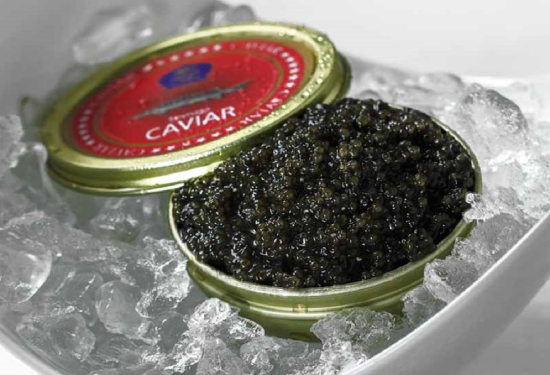
Imperial Caviar
The most expensive caviar is beluga-albino caviar often called "Almas". Almas is produced from the eggs of a rare albino sturgeon between 60 and 100 years old, which swims in the southern Caspian Sea where apparently less pollution exists. Very few of the albino variety are left in the wild since the lack of melanin is a genetic disorder that only affects a few members of the species. A kilogram (2 lb. 3 oz.) of this almost white "black gold" is regularly sold for greater than $30,000. Any additions by producers diminish the value of the roe, and the caviar usually reaches the market without any additions or processing whatsoever.
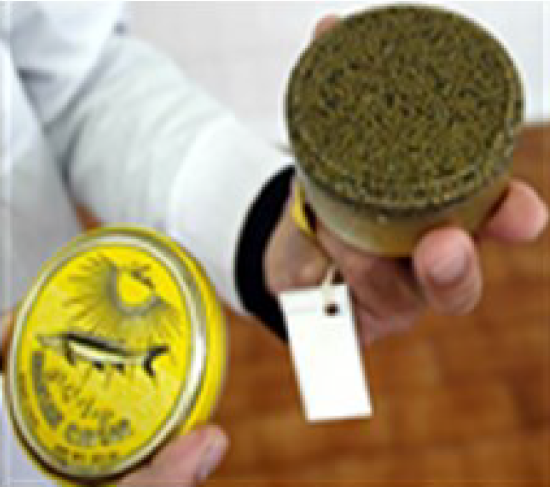
Other forms of Caviar
Payusnaya - Russian meaning “Pressed”
This caviar is made from broken skins and is pressed into a marmalade type roe. It is a favorite of Russians who like to spread this on toast.
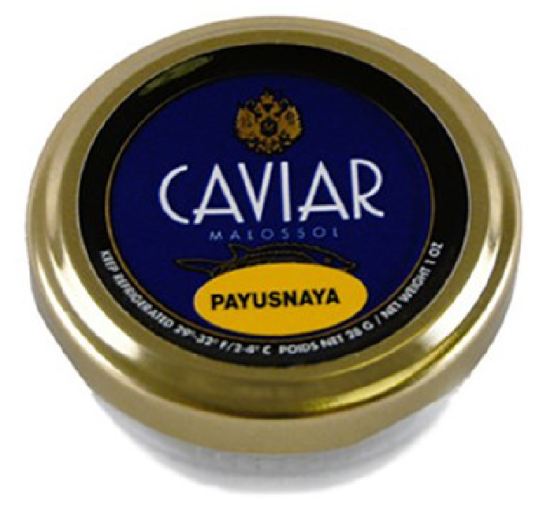
Kaluga
This is a farm-raised product from Siberia and China. The Kaluga (Huso dauricus) is a large predatory sturgeon found in the Amur River basin. Also known as the river beluga, they are claimed to be the largest freshwater fish in the world, with a maximum size of at least 1,000 kg (2,205 lb.) and 5.6 m (18.6 ft.). The Kaluga is one of the biggest of the sturgeon family. Like the slightly larger beluga, it spends part of its life in salt water. Unlike the beluga, this fish has five major rows of dermal scutes, nail-like teeth in its jaws, and feeds on salmon and other fish in the Amur. They have gray-green to black backs with a yellowish green-white underbelly.
The Kaluga has been hunted to near extinction for its valuable roe. Despite constant anti-poaching patrols, poachers continue to catch the fish. Fishing for Kaluga anywhere in the Amur River is an offense punishable by law. However, Kaluga’s are known to have an aggressive nature and instances of them toppling fishing boats and drowning anglers have been reported, although no concrete evidence exists of them assaulting or hunting people.
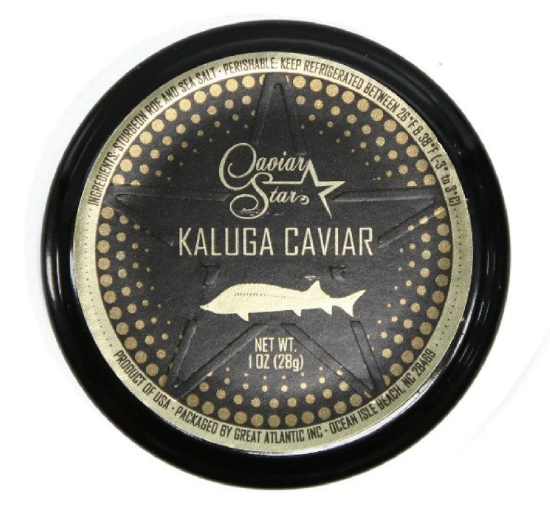
Kaluga caviar - caviarstar.com
When purchasing caviar, use a reputable supplier. Store at 28-32°F unopened for up to 4 weeks. After opening use within 2-3 days.
Buffet Service
What are Buffets?
Buffets are self- service food presentations where the guests choose their selections from platters, chafers, and action stations. The goal of a buffet is three fold.
- Encourage the guests to “stock up” from economically produced foods
- Keep the guests moving
- To encourage the perception of sumptuous abundance
The arrangement and appearance of a buffet rest on two key factors.
- Lavishness
- Abundance
The appearance of an abundance of food beautifully laid out is exciting and stimulating to the appetite.
There are ways to create this look:
- Color
- Height
- Full platters and bowls
- Proper spacing
- Simplicity- design is important; the trick is not to overdesign. Below is a great example.
- Orderliness- simple yet beautifully arranged food with a consistent style
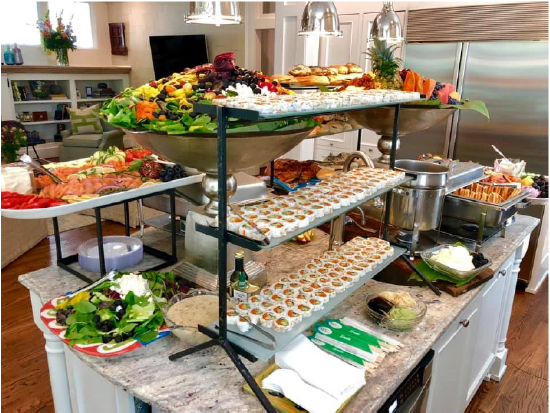
Photo courtesy of Keith Hand owner of Bridge Catering- Atlanta, Georgia
Menu and Service Sequence
Consider the following when arranging the buffet:
- Hot food are best served last.
- The most expensive items are usually placed after the lesser expensive ones.
- Place sauces and dressings adjacent to the items they go with.
- A separate dessert table is a good idea.
- Plates, of course, must be the first item on the buffet.
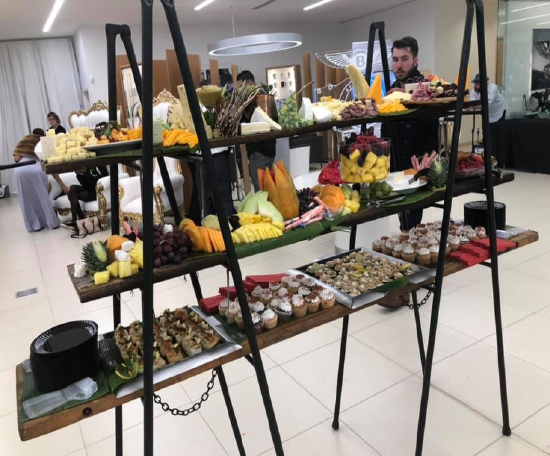
Photo courtesy of Keith Hand owner of Bridge Catering- Atlanta, Georgia
The Cocktail Buffet
- Tasty, well-seasoned, appetizer foods work best.
- Stacks of small plates at the start of the service point.
- Make the table easy to approach from all sides.
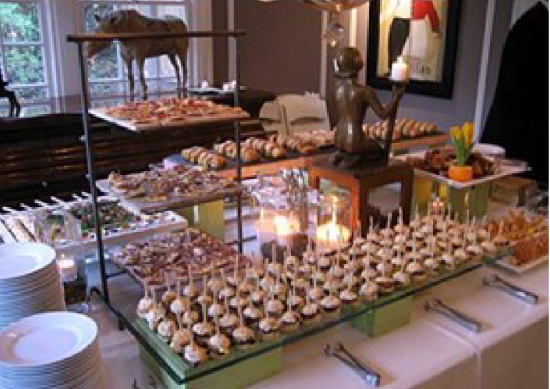
Photo courtesy of Keith Hand owner of Bridge Catering- Atlanta, Georgia
Determining the number of tables needed for your guests
Things to consider are the number of guests expected, the length of the serving time, the amount and type of service equipment needed, the type of menu, the style of service, the amount of décor desired, and the total floor space available for the function.
How to determine table space
Allocate approximately two running feet of buffet table for each food container or chafer. For three cold offerings, three hot offerings, and a condiment basket, you should set up a buffet table 14’ to 16’ long.
If you are setting up two 8’ rectangular tables, you will need 48 square feet of floor space and approximately 150 square feet of standard 3’ aisle space around the table for guests to serve themselves. For this setup, the total space needed is 200 square feet.
For each 50 people you need a single sided buffet. For each 75 people you need a double-sided buffet.
If the group has 150, you must have two double sided buffets and so on.
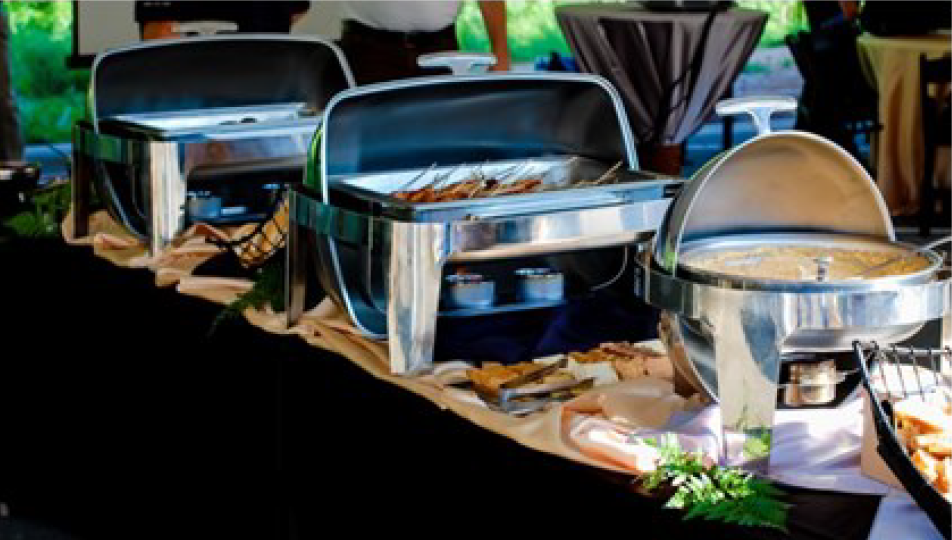
Double-side buffet line – commons. Wikipedia
Centerpieces
Floral arrangements of cut flowers, potted plants, or foliage combined with candles, lights, and even ice carvings are excellent centerpieces. Avoid flowers with bold aromas as they interfere with the palate. Centerpieces should not interfere with the guest line of sight. For height use an “epergne”- a container with a slender center portion that obstructs less. Consider the state of the flower’s usable lifespan on the day needed. If using roses in full bloom order” funeral roses, as they are in peak bloom. Store flowers between 38 and 45°F. If using ice sculpture be certain to have the proper drainage arrangement with the piece and a bucket hidden under the table skirting to catch melting.
Hors D’ Oeuvres, Caviar, and Buffet Presentation
- Explain the difference between hors d’ oeuvres and appetizers.
- Name the four types of hors d’ oeuvres.
- What are the four parts of a canapé?
- Since barquettes are boat-shaped, they should always include what? ______or___________.
- Bouchees are made from what?
- The essential key to successful completion of hors d’ oeuvres is
- What fish can be considered as true and legal caviar?
- What sea is the largest producer of this caviar?
- What caviar is the pride of Cajun and Creole country?
- Name three of the factors in grading caviar.
- What is Malossol caviar?
- List three characteristics of Beluga caviar.
- How does the flavor of Osetra caviar differ from Beluga caviar?
- Which has the strongest flavor of the three true caviars?
- Which caviar is golden or olive in color (2 names)?
- What is the definition of a buffet?
- What is the threefold goal of a buffet?
- In what ways does a chef create lavish abundance in the look of a buffet? (Six ways)
- Should you put the most expensive food at the beginning of the buffet?
- You will be serving 150 people at the buffet. How many buffets, and how many ‘sides’ do you need to conduct a smooth service?


